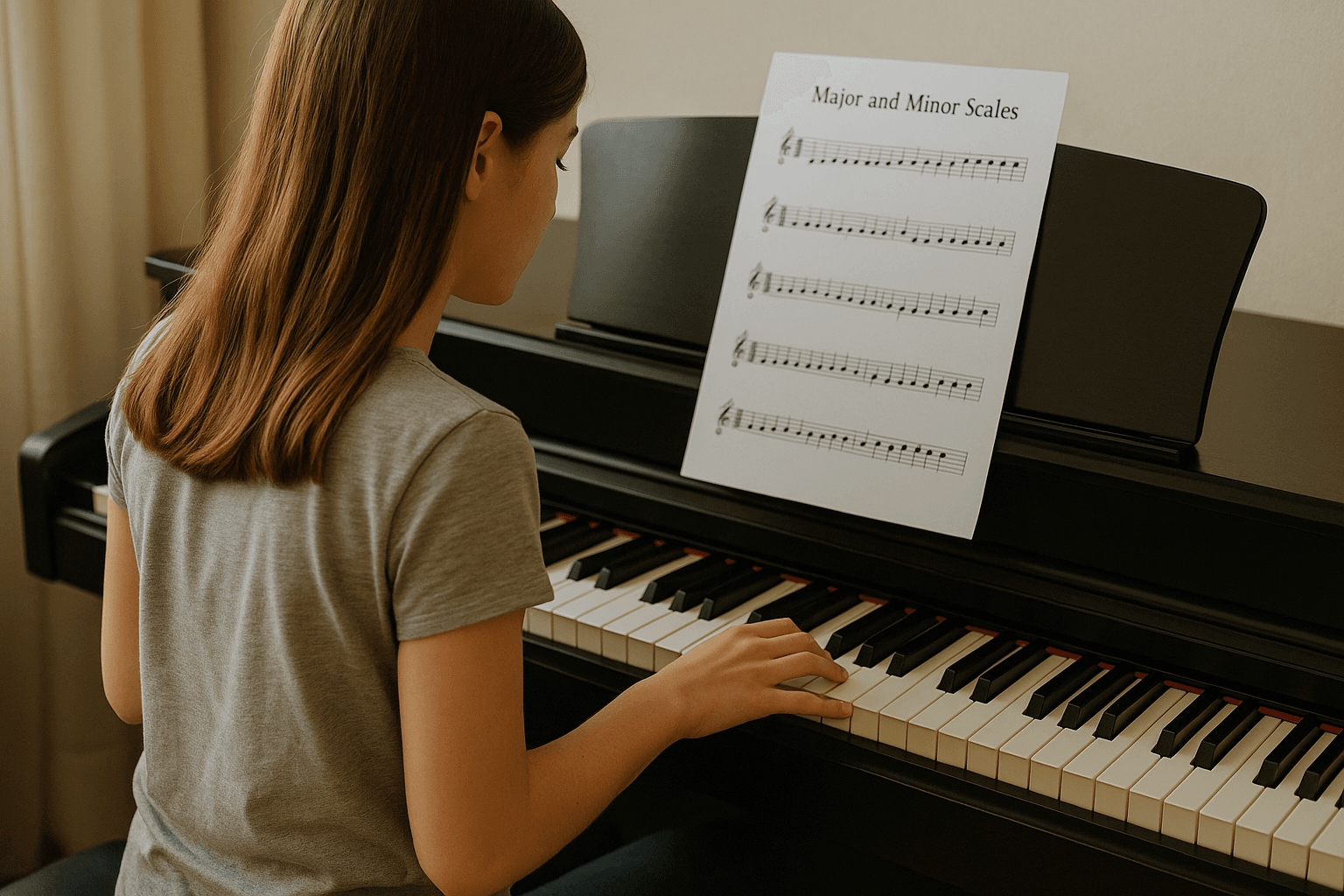
Art Gharana — 6 Mins read
Emotional Piano Songs to Play Today
Musical Instruments

Have you ever noticed how every pianist, from beginners to virtuosos, always comes back to scales? They aren’t just repetitive finger exercises; piano scales are the backbone of technique, fluency, and expression. Whether you’re polishing your fundamentals or aiming to master advanced passages, scales connect every note you play to a deeper understanding of music.
Think about it this way—when you practice the major scales piano patterns or explore the notes in a major scale, you’re not only building speed and accuracy. You’re also training your hands and ears to recognize the structure behind your favorite pieces. That’s why professional pianists treat scale practice as more than a warm-up; it’s a pathway to freedom at the keyboard.
In this blog, we’ll move beyond the standard piano scales chart and dive into advanced strategies that can make your practice sessions both challenging and rewarding. You’ll discover how to expand on familiar foundations, improve your precision, and apply scales directly to improvisation, composition, and performance.
So, if you’ve ever wondered how to transform routine drills into powerful tools for artistry, you’re in the right place. Let’s explore how advanced scale techniques can elevate your playing and open new possibilities every time you sit at the piano.
 Before diving into advanced techniques, it’s worth asking: what makes scales so essential for pianists at every level? The answer lies in how they connect theory, technique, and expression. Practicing scales isn’t just about moving your fingers across the keys—it’s about creating a solid framework that supports everything else you play.
Before diving into advanced techniques, it’s worth asking: what makes scales so essential for pianists at every level? The answer lies in how they connect theory, technique, and expression. Practicing scales isn’t just about moving your fingers across the keys—it’s about creating a solid framework that supports everything else you play.
Even if you’ve been playing for years, going back to the basic piano scales can transform your progress. Think of it as fine-tuning your foundation before adding new layers of skill. Mastering the notes in a major scale not only clarifies finger placement but also helps you hear how melodies and harmonies are constructed.
Many pianists fall into habits that hold back their growth:
If you’ve ever wondered how many piano scales are there, the answer reveals why variety matters—mastering the twelve major scales is just the beginning. Expanding your knowledge ensures flexibility and prepares you for real musical challenges.
By approaching scales as more than drills, you’ll begin to see them as stepping stones toward artistry. And if you want structured guidance tailored to your journey, exploring programs like online piano classes can make the process both effective and inspiring.
 Once you’ve built a solid foundation with the major scales piano, it’s time to challenge yourself with advanced variations. These techniques not only strengthen your technical skills but also unlock new creative possibilities. Have you ever wondered why professional pianists sound so fluid and expressive, even when playing something as simple as scales? It’s because they go beyond the basics.
Once you’ve built a solid foundation with the major scales piano, it’s time to challenge yourself with advanced variations. These techniques not only strengthen your technical skills but also unlock new creative possibilities. Have you ever wondered why professional pianists sound so fluid and expressive, even when playing something as simple as scales? It’s because they go beyond the basics.
Instead of playing scales in their standard form, try experimenting with inversions and shifting hand positions across the keyboard. This builds flexibility and expands your reach, preparing you for more complex passages.
Adding variety to your routine keeps practice fresh and engaging. The musical scales piano world doesn’t end with majors and minors:
Modes open doors to new tonal colors. By shifting the starting note of a familiar scale, you create a fresh sound palette. For example:
Each mode gives you the chance to experiment with musical storytelling.
Arpeggios are like scales in motion, and combining the two develops both accuracy and control. When practiced together:
If you’ve been relying only on the basic piano scales, this is your sign to push further. By weaving these advanced variations into your practice, you’ll not only refine your technique but also expand your expressive range. And if you’d like expert guidance, booking a free trial class can help you learn how to apply these ideas effectively.
 Speed and accuracy don’t come from simply playing faster—they come from mastering control. If you’ve ever felt your fingers stumble while working through piano keyboard scales, it’s a sign that your technique needs refinement rather than more speed. The good news? With the right strategies, you can achieve both precision and fluidity.
Speed and accuracy don’t come from simply playing faster—they come from mastering control. If you’ve ever felt your fingers stumble while working through piano keyboard scales, it’s a sign that your technique needs refinement rather than more speed. The good news? With the right strategies, you can achieve both precision and fluidity.
Every pianist dreams of fingers that move effortlessly. Building independence ensures each note in the music notes scale piano sounds clean and intentional. Try these simple but powerful drills:
One of the biggest challenges in keyboard scales is achieving balance between left and right hands. Often, the dominant hand overshadows the other, creating uneven sound. To fix this:
Repetition can easily become dull. Adding rhythmic twists makes scale practice both engaging and effective. For example:
A metronome is your best training partner for accuracy. Instead of jumping straight to fast tempos, layer your practice:
By blending these methods into your daily routine, you’ll not only play scales faster but also with confidence and control. And if you’d like structured routines crafted by experts, the Art Gharana online piano classes offer proven techniques to help you reach performance-level precision.
 Have you ever caught yourself asking, “When will I actually use all these scales in real music?” The truth is, scales aren’t just technical drills—they are tools that breathe life into your playing. When you understand how to apply them musically, every practice session feels more connected to performance and creativity.
Have you ever caught yourself asking, “When will I actually use all these scales in real music?” The truth is, scales aren’t just technical drills—they are tools that breathe life into your playing. When you understand how to apply them musically, every practice session feels more connected to performance and creativity.
Improvisation becomes far more natural when you have scales at your fingertips. For example:
This approach transforms scales from memorized exercises into a vocabulary for expression.
Sight-reading often feels intimidating, but it gets easier when you recognize familiar scale patterns. Since much of piano music is built on scale passages:
Scales and chords are two sides of the same coin. Understanding one strengthens your grasp of the other. For instance:
Many compositions demand smooth transitions between keys. Mastering the twelve major scales gives you the flexibility to navigate those changes seamlessly. Whether it’s a classical sonata or a jazz improvisation, knowing your scales makes modulation feel natural instead of daunting.
When you start viewing scales as musical tools rather than repetitive drills, your playing transforms. And if you’d like expert guidance on applying scales creatively, you can book a free trial class and experience how professionals integrate them into real music-making.
 Have you ever wondered why some pianists seem to improve rapidly while others plateau, despite practicing the same amount of time? The difference often lies not in effort, but in how you practice. Smart, structured practice with the right approach to piano key scales can make your journey faster, more efficient, and far more enjoyable.
Have you ever wondered why some pianists seem to improve rapidly while others plateau, despite practicing the same amount of time? The difference often lies not in effort, but in how you practice. Smart, structured practice with the right approach to piano key scales can make your journey faster, more efficient, and far more enjoyable.
Consistency beats random effort. By designing routines that cover all major scales piano chart, you ensure balanced development:
Repeating this cycle daily builds both muscle memory and mental familiarity with all major key notes.
Tracking progress keeps motivation high and highlights areas that need focus:
Scales are more than finger exercises—they’re tools for musicality. Combine technical drills with expressive practice:
Even advanced pianists can feel drained by repetitive drills. To keep it fresh:
With the right approach, scale practice becomes a tool for lifelong growth. And if you want structured, guided routines tailored to your level, explore our online piano classes to make every practice session count.
Have you ever prepared for a recital or audition and felt your scale practice didn’t fully translate to performance? Playing scales technically well in isolation is one thing, but performing them with confidence, musicality, and precision is a different skill altogether. Piano scales are your secret weapon—they build not just technique, but also poise and control on stage.
When scales are part of a performance requirement, it’s important to approach them strategically:
Scales are an opportunity to showcase musical expression:
Nerves can affect even the best-prepared pianist. These strategies help you stay calm and focused:
Listening critically to your own recordings accelerates growth:
By mastering scales at a performance level, you not only polish technique but also elevate your musicality and stage presence. If you’re ready to take your scale practice to professional heights, consider joining online piano classes where expert instructors guide you step by step toward confident, expressive playing.
Mastering piano scales is more than a technical exercise—it’s a journey that transforms the way you play, listen, and create music. By exploring advanced techniques, integrating rhythmic and harmonic variations, and applying scales in real musical contexts, you’re building a foundation that supports both technical mastery and artistic expression.
Ask yourself: Are you practicing scales just as drills, or are you using them as tools to unlock your full musical potential? Every scale, whether a major scale piano or a chromatic pattern, is an opportunity to refine your touch, expand your creativity, and gain confidence at the keyboard.
Remember, consistent, structured practice combined with musical application is the key to long-term progress. Whether you want to elevate your improvisation skills, prepare for performances, or simply enjoy playing with greater fluidity, the path is clear: embrace scales as a vital part of your musical journey.
If you’re ready to take your practice to the next level, explore expert guidance through online piano classes or book a free trial class to get personalized instruction and make every practice session count. Your journey toward mastery starts one scale at a time—why not begin today?